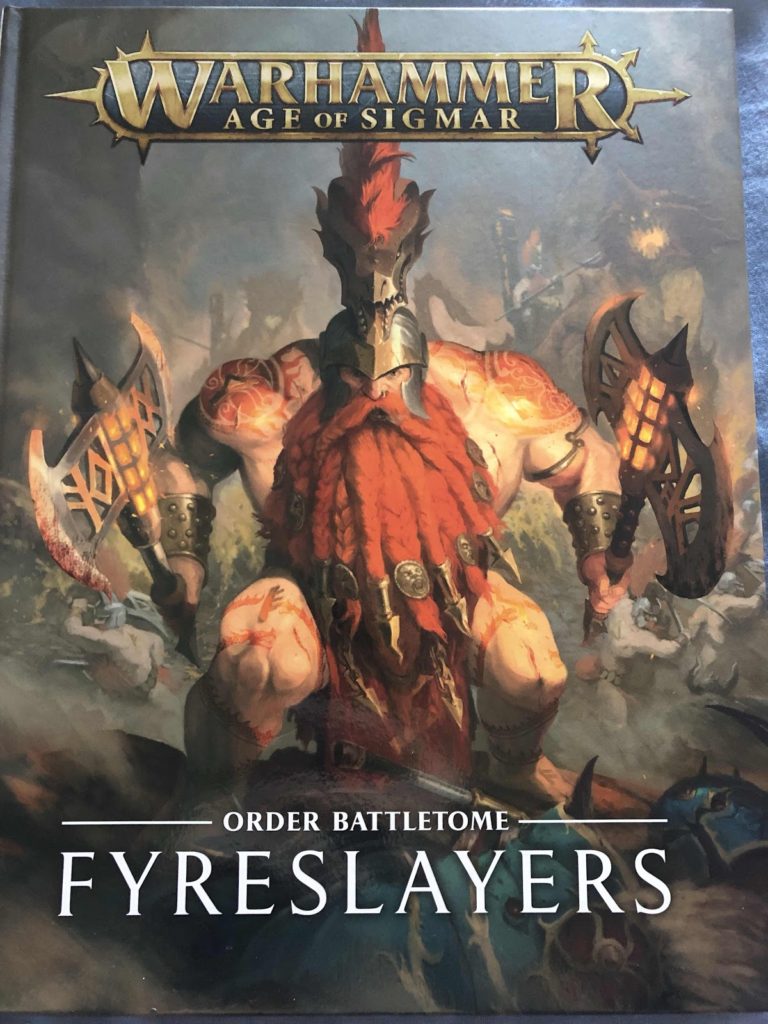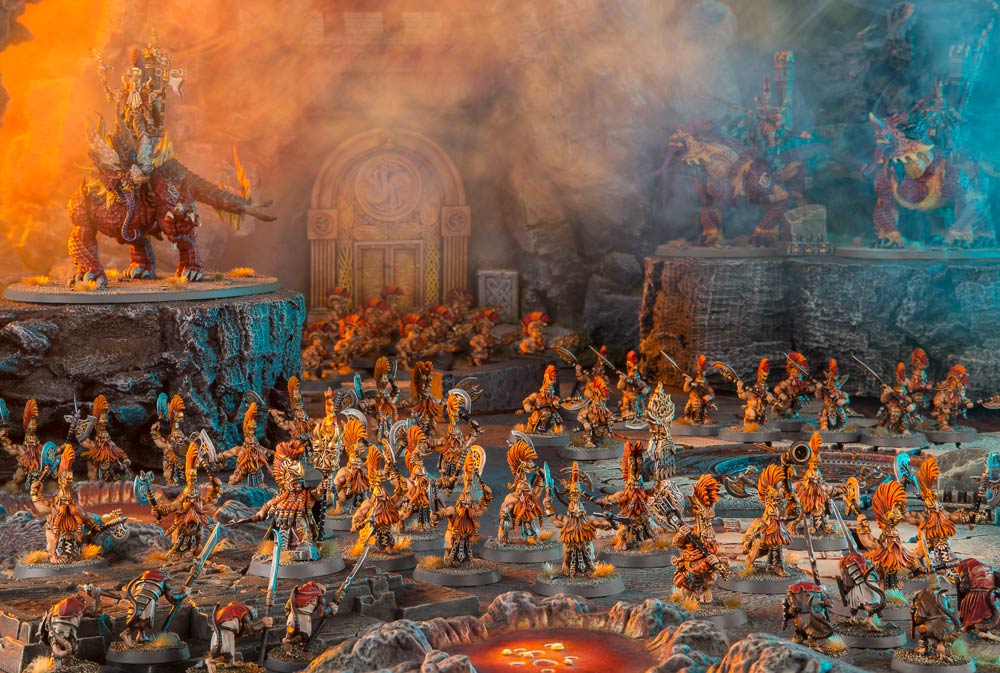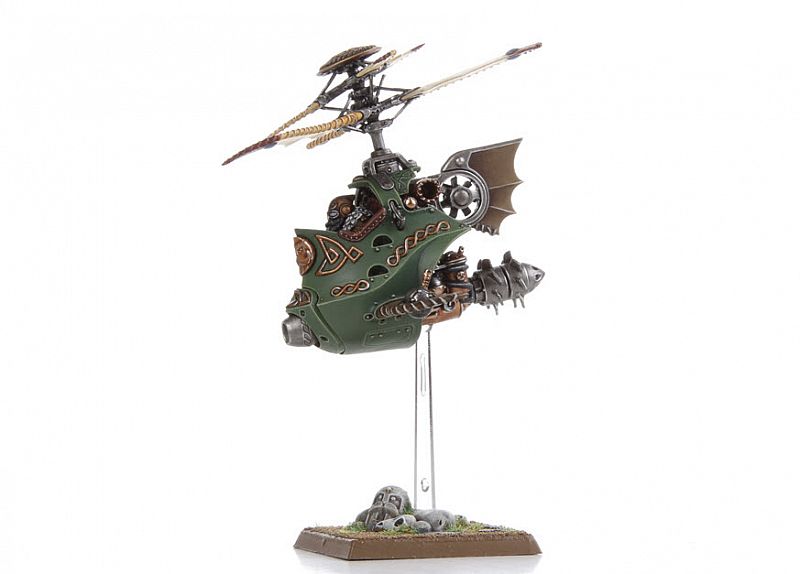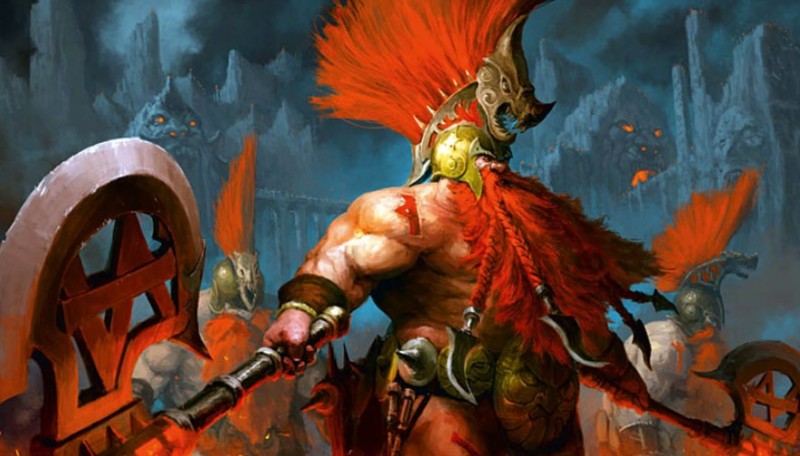They have been bottom-tier, mid-tier, and top-tier, but where do the Fyreslayers find themselves in today’s competitive AoS landscape? Let’s take a look.
As one of Age of Sigmar’s earliest “original” armies, the little naked brawlers of the Fyreslayers have had their fair share of adventures both among hobbyists and players. Born in an area during which AoS was still finding its footing in terms of both rules, and pricing, the army saw an early reputation of being extremely expensive to purchase, and also extremely elite, albeit not powerful. In the years since they briefly saw themselves as solid (thanks to some points adjustments), and for a while were even considered overwhelmingly powerful.
Why does this army’s power level seem to fluctuate so dramatically, and more importantly, with 2020 dawning, and a Winter FAQ behind us, where do the Fyreslayers land now?

The answer to the first question is actually a fairly easy one. The Fyreslayers were and remain a book with surprisingly few units. Despite having a healthy, and varied assortment of heroes, the core of the book beyond them is literally three units. With such finite options for building the bulk of an army, even a modest change to one unit can alter its fate dramatically. While the aim of this article is to talk tactics, as always, I don’t mind editorializing a moment in saying that perhaps a Lodge allowing 50% of unit to be taken from those warscrolls with the Duardin keyword would do wonders for their list-building diversity.
But I digress, and to the second of my questions I say this. The Fyreslayers were still strong and viable in the competitive scene before our Winter 2019 FAQ, and now are even better.
It goes without saying, but to those new to the Fyreslayers, the definitive build that keeps them relevant is bulk Hearthguard Berzerkers, coupled with a bevy of support heroes, and the incredible Lords of the Lodge battalion. Since that is so central to the ethos of competitive Fyeslayers, lets dig into that and explain its potency.

Berzerkers, battleline under a Runefather general, are solid workhorses, with two wounds each, and a 5+/6++ save. Their two weapon options sport 2” melee reach making it easy for everyone in the unit to contribute, and spoiler-alert, the math-hammer is such that either weapon provides roughly the same over-all damage except in edge cases against specific saves. They seem decidedly “fine” until you realize that, as is often the case in AoS, the best units are those best receptive of the most kinds of buffs.
A single hero within 10” of even one Berzerker increases their aftersave from a 6++ to a 4++. Considering the value of mortal wound saves, this has already exponentially increased their value. Since you need a hero within 10” of them, why not make it a Battlesmith who when wholly within 12” (or 18” with a wonderful artifact option) suddenly makes their initial save one better. Now if you are buffing them anyway, any Priest may use a Prayer of Ash on them on a 4+ (a 3+ when utilizing your free terrain pieces, to boot). With this very modest amount of support (not even the full spectrum of buffs you could be giving them), the Berzerkers are currently sitting on a 3+/4++ save, making them virtually unkillable to low-rend armies, and still very durable against those with modest access to rend.
This unit becomes the appropriately named definition of an “anvil”, the unit you shove in you opponents face, and demand that they shift, or get bogged down in.

Inevitably, the competitive Fyreslayer general will take them in Lords of the Lodge battalion which takes every one of their strengths, and increases them. Here players may spend a CP to choose this unit to fight twice in combat. Now your anvil, already modestly killy, becomes an outright hammer. The raw efficiency of a unit in your army fulfilling both roles cannot be undersold, and, against many opponents, will turn the center of the table into an impassible wall of death.
The army book, as with all later 2nd Edition battletomes, also offers a choice of “Lodge” for further benefit. While several are valid, interesting choices, most discriminating players looking to squeeze every bit of efficiency out of their list are likely to pick Hermdar. This means that your anvil, when wholly within 12”of an objective, or when in your opponent’s territory, never takes battleshock, and more notably, can spend a CP to strike first in ANY fight phase. As of the Winter 2019 FAQ, this means that even against Hedonites of Slaanesh and their Loci, you will be striking first.
Between all of those factors, it becomes clear that for good or ill, it is the proper use of the Berzerker units that will likely win or lose games for you, and it is here where another of our Winter FAQ changes subtly boosts the Fyreslayers.
Once taken in huge, expensive blocks of thirty models (in order to benefit from a large-unit discount), the Berzerkers would tend to be a very high execution death-star. The unit would traditionally never die, but keeping it in range of its much-desired buffs meant positioning was crucial, and its table control could be surprisingly limited. Now, post-changes, units cap at twenty models where they receive a lesser discount, and yet which makes them significantly easier to use. I would also be remiss if I didn’t point out how easy it is to fit two, twenty-man units in a list. Yes, only one could be a Lords of the Lodge member, but heroes can easily move their buffs, with good placement, as a redundancy if a unit does find itself whittled down over the course of a game.

Now, while my articles generally like to focus on all of the competitive ways to build from a given book, the reality is that Berzerkers as a core ARE the sole way to do so at this time. However, where list-building aficionados can take solace is in what you choose to build AROUND your Berzerkers, which is how you will actually win the objective game.
Currently, my two favorite options come from within the book, in the form of Auric Hearthguard, and from Cities of Sigmar, in the form of Gyrocopters.
Auric Hearthguard, when paired with the ever valuable Runesmiter, become a flexible unit of deepstriking monster hunters or assassins. Being able to pop up 9” away from enemy models, but with 18” guns can allow this unit to serve purposes such as grabbing under-protected backfield objectives, or removing clutch support pieces. Just as easily the Runesmiter can abandon the unit and instead give his unbelievable re-roll wounds prayer to your murderball of Berzerkers, while the Hearthguard (potentially immune to battleshock if Hermdar) tend to themselves and inevitably disrupt some of your opponent’s planning.
Gyrocopters, the zippy-fast little objective grabbers and horde-clearers of the Cities of Sigmar, make a fluffy and fun option to consider as well. Thanks to a unit discount, two units of three Gyrocopters can comfortably fit the allies allowance at 2000pt game size, and against many armies, will earn back their humble cost thanks to their street-sweeping Steam Guns. Volume of dice are a very real way to add value to a list, and it isn’t unreasonable to roll ninety dice in a big block of enemy infantry. With some restraint these models can comfortably hang behind frontlines for later game scoring, and even contribute some shooting to provide added value. Mobility is something Fyreslayers innately lack, making these a good way to fill some gaps.

When sitting opposite a Fyreslayer army, or while in control of one, there are weaknesses to be very mindful of. The most prominent of these is in their deep reliance on their relatively fragile heroes. Every hero killed dramatically reduces the usefulness of the army on the whole. Even a mis-positioned hero opens the door for an opponent to take a more significant chunk out of a key unit. Traditionally the “counter” to this comes in the form of either the (not)Endless Spell Runic Fyrewall to block line-of-sight to these heroes, or a bodyguard unit of Auric Hearthguard who can take a chunk of damage directed at the heroes on themselves as ablative wounds. In either case, though, this already elite army is forced to spend precious points that it would rather be using on more forward-pushing fighters.
In closing, I actually think Fyreslayers are poised for a strong 2020 on the competitive stage. With one of their hardest counters somewhat undermined, the Fyreslayers stand to see increases in popularity, and more success at bigger events. While I would love to see the range broadened for the longer term health of the faction, I suspect tournaments will still very much be a case of “sun’s out, buns out” for the naked little beat-sticks.
And remember, Frontline Gaming sells gaming products at a discount, every day in their webcart!



